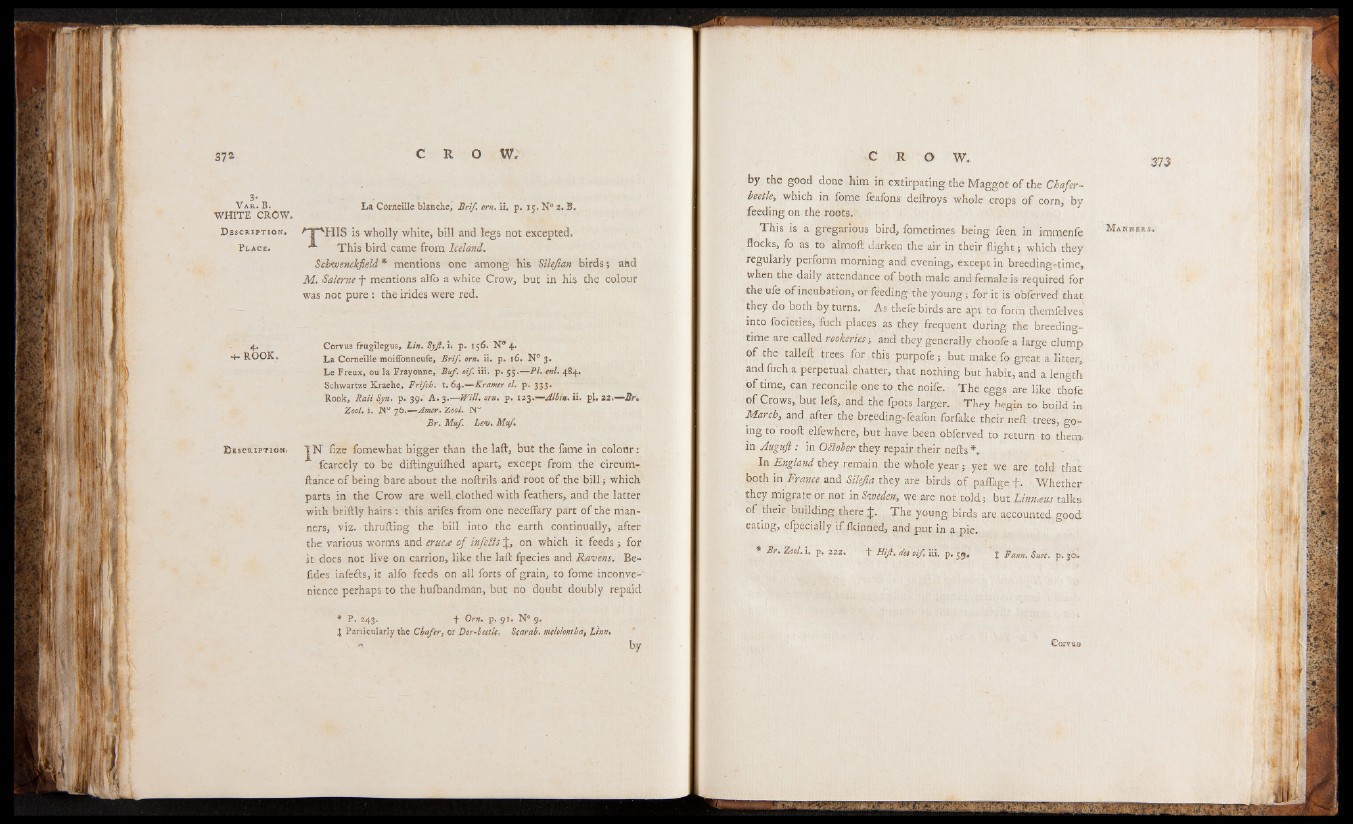
37 2 C R O W .
3- V a r . B.
WHITE CROW.
D e s c r i p t io n .
P l a c e .
+. R4O-OK.
D e s c r i p t io n .
La Corneille blanche, B r i f orn. ii. p. 15. N° 2. B.
^T^HIS is wholly white, bill and legs not excepted.
"*■ This bird came from Iceland.
Schwenckfield * mentions one among his Silejtan birds; and
M. Salerne f mentions alfo a white Crow, but in his the colour
was not pure: the irides were red.
Corpus frugilegus, Lin. Sy jl.u p. 156. N° 4*
La Corneille moifionneufe, Hr if. orn. ii. p. 16. N° 3.
Le Freux, ou la Frayonne, Buf. oif. iii. p. 55.—PI. ml. 484.
Schwartze Kraehe, Frifcb. t. 64.— Kramer el. p. 333.
Rook, Rati Syn. p. 39. A. 3.—Will. orn. p. 123.—Albin. ii. pi. 22.—B r .
Z o o l.i. N' 76.—Amer. Z oqI. N°
B r . Muf. Le v. Muf.
IN lize fomewhat bigger than the laft, but the fame in colour:
fcarcely to be diftinguilhed apart, except from the circum-
ftance of being bare about the noftrils arid root of the bill; which
parts in the Crow are well, clothed with feathers, and the latter
with briftly hairs: this arifes from one necefiary part of the manners,
viz. thrufting the bill into the earth continually, after
the various worms and erucse of infers J, on which it feeds ; for
it does not live on carrion, like the laft fpecies and Ravens. Be-
fides infefts, it alio feeds on all forts of grain, to fome inconvenience
perhaps to the hulbandman, but no doubt doubly repaid
* P. 243. f Orn. p. 91. N° 9.
X Particularly the Chafer, or Dor-beetle, Scarab, melolontha, lin n ,
■ by
C R O W . 373
by the good done him in extirpating the Maggot of the Chafer-
beetle, which in fome feafons deftroys whole crops of corn, by
feeding on the roots.
This is a gregarious bird, fometimes being feen in immenfe
flocks, fo as to almoft darken the air in their flight j which they
regularly perform morning and evening, except in breeding-time,
when the daily attendance of both male and female is required for
theufe of incubation, or feeding the young; for it is obferved that
they do both by turns. As thefe birds are apt to form themfelves
into focieties, fuch places as they frequent during the breedingtime
are called rookeries; and they generally choofe a large clump
of the tailed: trees for this purpofe; but make fo great a litter,
and fuch a perpetual chatter, that nothing but habit, and a length
of time, can reconcile one to the noife. The eggs are like thofe
of Crows, but lefs, and the fpots larger. They begin to build in
March, and after the breeding-feafon forfake their neft trees, going
to rooft elfewhere, but have been obferved to return to them,
in Auguft: in Otlober they repair their nefts
In England they remain the whole year; yet we are told that
both in France and Silefia they are birds of paflagef . Whether
they migrate or not in Sweden, we are not told; but Linnaus talks
of their building there J. The young birds are accounted good
eating, efpecially if fldnned, and put in a pie.
* B r .Z oo l. 1. p . EM . + Hijl. ties oif. iii. p, 5.9., J tu r n . Sate, p . j o t
M a nne r s *
Cor vus